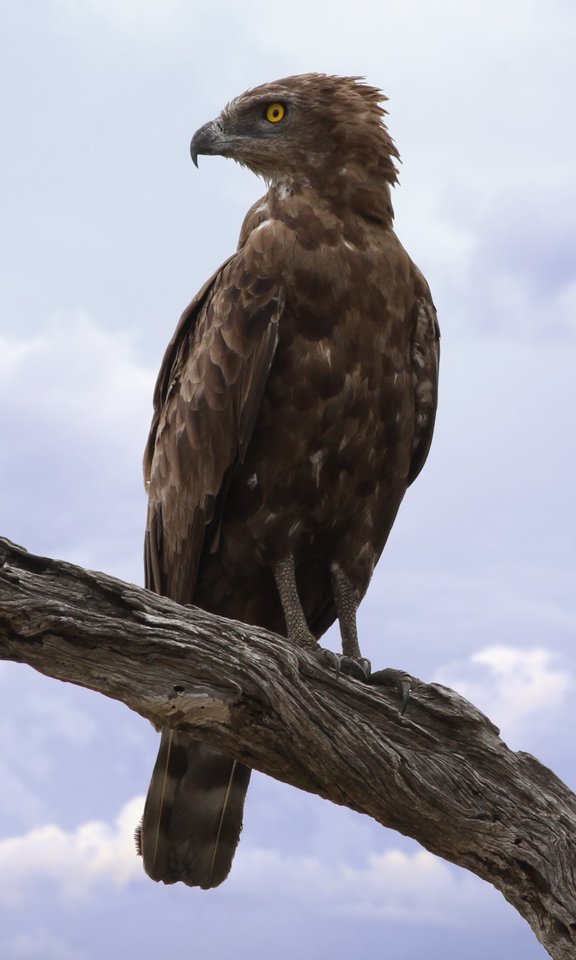Brown snake eagles are not cold-blooded. They are birds, and like all birds, they are warm-blooded, or endothermic. This means they maintain a constant body temperature, regardless of their environment.
What are Brown Snake Eagles?
Brown snake eagles are large birds of prey found in sub-Saharan Africa. They are known for their distinctive dark brown plumage and large head. Adults have dark brown plumage with slight white mottling on the flight feathers, while juveniles are similar to adults but may be slightly paler or have fine pale feather edges. Chicks are covered in white down.
Hunting Behavior of Brown Snake Eagles
 Image source: Brown snake eagle By Derek Keats
Image source: Brown snake eagle By Derek Keats
These eagles are specialized hunters of snakes and other reptiles. They have thick-skinned legs that protect them from bites, and they carry their prey by the head while flying. They spend most of their time perched in trees, performing short flights from tree to another, and hunting from these perches.
Characteristics of Brown Snake Eagles
Here are some key characteristics of brown snake eagles:
| Characteristic | Description |
|---|---|
| Body Temperature | Warm-blooded (endothermic) |
| Plumage | Dark brown with white mottling on flight feathers (adults), slightly paler with fine pale feather edges (juveniles), white down (chicks) |
| Head | Large |
| Hunting Prey | Snakes and other reptiles |
| Hunting Technique | Perch-and-pounce, carry prey by the head while flying |
| Habitat | Sub-Saharan Africa |
Why Brown Snake Eagles are Not Cold-Blooded
As mentioned earlier, brown snake eagles are not cold-blooded. They are birds, and like all birds, they are warm-blooded, or endothermic. This means they maintain a constant body temperature, regardless of their environment.
Cold-blooded animals, also known as ectotherms, rely on external sources of heat to regulate their body temperature. They cannot generate their own body heat and their body temperature fluctuates with the temperature of their surroundings.
In contrast, warm-blooded animals, or endotherms, can generate their own body heat and maintain a relatively constant body temperature, even in changing environmental conditions. This is achieved through various physiological mechanisms, such as shivering, sweating, and adjusting their metabolic rate.
As birds, brown snake eagles are endotherms and can maintain a stable body temperature, which is essential for their survival and optimal functioning.
Adaptations of Brown Snake Eagles
Brown snake eagles have several adaptations that help them thrive as specialized hunters of snakes and other reptiles:
- Thick-Skinned Legs: Their thick-skinned legs protect them from the bites of their prey, allowing them to grasp and carry snakes without injury.
- Head-Carrying Technique: They carry their prey by the head while flying, which helps them maintain control and prevent the snake from coiling around their body.
- Perch-and-Pounce Hunting: They spend most of their time perched in trees, scanning the ground for potential prey. This allows them to conserve energy and strike quickly when they spot a snake or other reptile.
- Powerful Talons: Their strong talons are well-suited for grasping and tearing their prey.
- Keen Eyesight: Brown snake eagles have excellent eyesight, which helps them spot their prey from a distance and track their movements.
Conclusion
In conclusion, brown snake eagles are not cold-blooded. They are warm-blooded birds that maintain a constant body temperature, regardless of their environment. These specialized hunters of snakes and other reptiles have several adaptations that allow them to thrive in their habitat, including thick-skinned legs, a head-carrying hunting technique, and a perch-and-pounce hunting strategy.
References:
- Brown snake eagle – Wikipedia https://en.wikipedia.org/wiki/Brown_snake_eagle
- Brown Snake Eagle – Carnivora https://carnivora.net/brown-snake-or-brown-harrier-eagle-circaetus-ciner-t2419.html
- Brown snake eagle – Animalia https://animalia.bio/brown-snake-eagle
- Brown snake eagle – African Bird Club https://africanbirdclub.org/bird-info/brown-snake-eagle/

